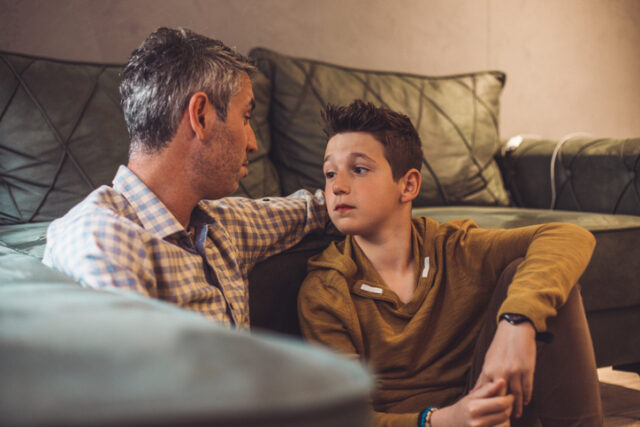Contrary to popular belief, setting boundaries with your child doesn’t have to feel like a battle.

Kids naturally test limits, but that doesn’t mean you have to turn every situation into a strict, no-nonsense rule. The key is finding a balance between being firm and keeping things lighthearted. When boundaries are set playfully, kids are more likely to respect them without resistance. Using humour, creativity, and a little bit of fun, you can teach your child about limits while keeping your bond strong — here’s how to do exactly that.
1. Turn “no” into a game.

Instead of just saying no outright, turn it into a fun challenge. If your child wants something they can’t have, say, “Let’s see how long you can go without asking me again — ready, set, go!” It makes the boundary feel like part of a game rather than just a rule being enforced. It sounds ridiculous, but it works!± Kids love challenges, and if you make it fun, they’ll be more likely to go along with it. It shifts their focus from what they can’t have to the playful nature of the moment, making boundaries feel less like a punishment and more like an interactive experience.
2. Use a “silly meter” to manage tone.

When kids get too loud or silly at the wrong time, instead of saying, “Stop it,” try using a “silly meter.” Say, “Uh-oh, your silly meter is reaching maximum level! Let’s turn it down a notch before it explodes!” This way, you keep them engaged while also reminding them to adjust their behaviour. Using an imaginary concept like a silly meter adds an element of fun while still enforcing limits. Kids are more likely to respond positively when they feel like they’re part of the process rather than just being told what to do.
3. Offer a “boundary buddy.”

Sometimes, kids struggle with limits simply because they forget. Instead of constantly reminding them yourself, let them pick a “boundary buddy” — a stuffed animal, a small toy, or even a drawing of a character that helps remind them of the rules. For example, if they always leave their shoes in the wrong place, their boundary buddy can “watch over” them and remind them to put them away. It turns responsibility into a shared experience, making boundaries feel less like rules and more like teamwork.
4. Let them beat the clock.

Kids love a good race, so if they resist a boundary (like tidying up or getting ready for bed), make it a game. Say, “I bet you can’t clean up all your toys before this song ends!” or “Can you brush your teeth faster than me? Let’s see!” Turning a boundary into a challenge makes it feel like a fun activity rather than a demand. Plus, kids are much more likely to cooperate when they feel like they have a sense of control and a reason to engage.
5. Use a “boss of the moment” strategy.

Kids love feeling in charge, so flip the script by making them the “boss” of the rule they need to follow. Say, “You’re the boss of handwashing today — can you remind me how long we’re supposed to wash for?” It makes them feel involved rather than just being told what to do. When kids feel empowered, they’re more likely to listen. Giving them temporary control over a rule helps them internalize it in a fun way while still keeping them accountable.
6. Create a magic phrase for boundaries.

Instead of repeating yourself over and over, introduce a fun phrase that signals a boundary. It could be something like, “Freeze like a statue!” when they need to stop what they’re doing or “Bubble hands!” to remind them to wash up before meals. Kids respond better to playful instructions than repeated nagging. Making boundaries feel like part of an inside joke between you and your child keeps them engaged and makes following the rules feel like a shared experience rather than a command.
7. Use the “if-then” approach with a twist.

Traditional if-then statements can feel like threats, but adding a playful twist keeps them lighthearted. Instead of saying, “If you don’t clean your room, no TV,” try, “If your toys don’t make it back home, they might get lost on an adventure!” Kids love a good story, and this approach makes the boundary feel less like a punishment and more like a natural part of life. It flips the focus from consequences to curiosity, making them more likely to cooperate.
8. Use funny voices for reminders.

Instead of constantly repeating yourself in frustration, switch things up with a funny voice. If your child is ignoring their bedtime routine, say, “Captain Toothbrush here, reporting for duty! Who’s ready for a brushing mission?” Using humour in boundary-setting keeps kids engaged while making the moment less tense. They’re much more likely to listen when the request feels fun rather than forced.
9. Introduce pause buttons.

When kids get too wound up, introduce an imaginary pause button. Say, “Uh-oh, we’re getting a little too wild! Let’s hit the pause button and reset.” You can even pretend to press a button on their forehead or use a hand motion. This strategy gives kids a moment to regain control without feeling like they’re being punished. It makes self-regulation more interactive, which is often more effective than simply telling them to calm down.
10. Turn transitions into missions.

Moving from one activity to another can be tough for kids, so make it an adventure. Instead of saying, “It’s time to leave the park,” say, “Mission complete! Let’s head back to base for snack time.” Framing transitions as exciting missions makes them feel less abrupt and more engaging. Kids love the idea of completing a task, and it makes leaving an activity feel more like an achievement rather than an interruption.
11. Use a reverse rule.

When kids resist boundaries, flip the expectation in a playful way. If they refuse to put their shoes on, say, “Oh no, I guess we have to go outside barefoot like jungle explorers!” or if they won’t eat veggies, say, “I was hoping to have all the carrots to myself!” Turning resistance into a silly moment helps lower their defensiveness. It shifts the focus from the power struggle to playfulness, making them more likely to cooperate.
12. Give the boundary a character.

Kids love stories, so make the rule part of one. If they forget to wash their hands, say, “Uh-oh, the Germ Goblins are sneaking around! Quick, let’s wash them away!” or if they won’t clean up, say, “The Toy King says all toys must return to their castle!” Adding imagination to boundaries makes them feel less like rules and more like fun moments. Kids engage more when there’s a story behind what they need to do.
13. Offer a silly solution first.

If your child is resisting something, suggest an obviously ridiculous alternative first. If they don’t want to put on their coat, say, “Well, I suppose we could just wrap you in 10 blankets instead!” or if they won’t have a bath, say, “We could always just roll around in soap bubbles instead!” Kids love absurd humour, and offering a silly solution first makes the real option seem more appealing. It lightens the mood while still reinforcing the boundary.
14. Turn limits into choices.

Instead of making rules feel rigid, offer kids choices within the boundary. Instead of saying, “Time to go to bed,” say, “Do you want to hop like a bunny or tiptoe like a ninja to bed?” This way, they still feel like they have control. Giving kids a sense of autonomy makes them more willing to cooperate. They still have to follow the rule, but choosing how they do it makes it feel less restrictive.




